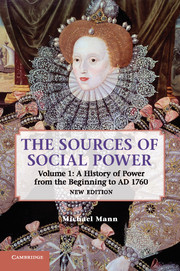Book contents
- Frontmatter
- Contents
- Preface to the new edition
- Preface
- 1 Societies as organized power networks
- 2 The end of general social evolution: how prehistoric peoples evaded power
- 3 The emergence of stratification, states, and multi-power-actor civilization in Mesopotamia
- 4 A comparative analysis of the emergence of stratification, states, and multi-power-actor civilizations
- 5 The first empires of domination: the dialectics of compulsory cooperation
- 6 “Indo-Europeans” and iron: expanding, diversified power networks
- 7 Phoenicians and Greeks: decentralized multi-power-actor civilizations
- 8 Revitalized empires of domination: Assyria and Persia
- 9 The Roman territorial empire
- 10 Ideology transcendent: the Christian ecumene
- 11 A comparative excursus into the world religions: Confucianism, Islam, and (especially) Hindu caste
- 12 The European dynamic: I. The intensive phase, a.d. 800–1155
- 13 The European dynamic: II. The rise of coordinating states, 1155–1477
- 14 The European dynamic: III. International capitalism and organic national states, 1477–1760
- 15 European conclusions: explaining European dynamism – capitalism, Christendom, and states
- 16 Patterns of world-historical development in agrarian societies
- Index
- References
8 - Revitalized empires of domination: Assyria and Persia
Published online by Cambridge University Press: 05 July 2013
- Frontmatter
- Contents
- Preface to the new edition
- Preface
- 1 Societies as organized power networks
- 2 The end of general social evolution: how prehistoric peoples evaded power
- 3 The emergence of stratification, states, and multi-power-actor civilization in Mesopotamia
- 4 A comparative analysis of the emergence of stratification, states, and multi-power-actor civilizations
- 5 The first empires of domination: the dialectics of compulsory cooperation
- 6 “Indo-Europeans” and iron: expanding, diversified power networks
- 7 Phoenicians and Greeks: decentralized multi-power-actor civilizations
- 8 Revitalized empires of domination: Assyria and Persia
- 9 The Roman territorial empire
- 10 Ideology transcendent: the Christian ecumene
- 11 A comparative excursus into the world religions: Confucianism, Islam, and (especially) Hindu caste
- 12 The European dynamic: I. The intensive phase, a.d. 800–1155
- 13 The European dynamic: II. The rise of coordinating states, 1155–1477
- 14 The European dynamic: III. International capitalism and organic national states, 1477–1760
- 15 European conclusions: explaining European dynamism – capitalism, Christendom, and states
- 16 Patterns of world-historical development in agrarian societies
- Index
- References
Summary
Greece was one polar type of reaction to the northern challenges discussed in Chapter 6. The other pole was the revitalized empire of domination. The main empires contemporaneous with the Phoenician and Greek history just covered were Assyria and Persia. My treatment is brief and sometimes uncertain because sources are not nearly as good as they are for Greece. Indeed, much of our knowledge of Persia is gleaned from Greeks' accounts of their great struggle – an obviously biased source.
In Chapter 5, I set out the four main strategies of rule for the ancient empire: to rule through conquered elites; to rule through the army; or to move toward a higher level of power, through a mixture of the “compulsory cooperation” of a militarized economy and the beginnings of a diffused upper-class culture. On the one hand, the coming of the iron plow and the expansion of local trade, coinage, and literacy tended to decentralize the direction of economic development, making compulsory cooperation somewhat less productive and less attractive as a strategy. On the other hand, the growing cosmopolitan character of these processes facilitated the diffusion of broader class-cultural identities that could also be used as an instrument of rule.
- Type
- Chapter
- Information
- The Sources of Social Power , pp. 231 - 249Publisher: Cambridge University PressPrint publication year: 2012



